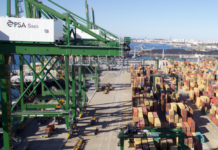
The share of the container ship fleet with scrubbers installed exceeded that of the crude oil tanker fleet by the start of July – as container ships with a collective cargo-carrying capacity of 5.3 million TEU are now fitted with the exhaust gas cleaning systems (EGCS).
However, while the scrubber-fitted fleet of main cargo-carrying ship types now counts 2,600 ships, most of the fleet – around 70,000 ships – are still without a scrubber. In the past couple of weeks, it has been a rather quiet period in the bunker industry, with relatively low prices and abundant supply generally.
The World Bunker Index MABUX has not had any firm trend in the last seven days and changed irregularly. The 380 HSFO index rose slightly to US$310/mt, VLSFO increased marginally to US$368/mt, while MGO fell to US$445/mt.

The global scrubber spread (the price difference between 380 HSFOs and VLSFOs) remained relatively stable, averaging US$58.07/mt. At the same time, average spread in Rotterdam has risen to US$50.67/mt and has dropped to US$62.00/mt in Singapore.

As per VeriFuel, the global market share of VLSFO increased from 49% in the first three months of 2020 to 52% in the second quarter. The percentage for high sulphur fuel oil (HSFO) remained the same across both quarters, at 8%.
Low sulphur marine gasoil fell back slightly, from 38% in Q1 to 36% in Q2. High sulphur marine gasoil remained the same at 1%, while the share of ultra-low sulphur fuel oil (ULSFO) changed from 4% in Q1 to 3% in Q2. Besides, in January this year, 4% of samples tested by VeriFuel were found to be off-spec. The percentage has changed slightly month on month, with June showing the lowest number of off-specs – just 2%.

Environmental group HFO-Free Arctic has stressed the urgency of acting to reduce the impact of shipping on the region, pointing to data showing a sharp rise in black carbon emissions there in recent years. The NGO has continued this campaign in 2020 despite the switch from high sulphur fuel oil to very low sulphur fuel oil (VLSFO) — which the majority of the bunker industry is convinced should already have delivered at least some reduction in black carbon emissions.





